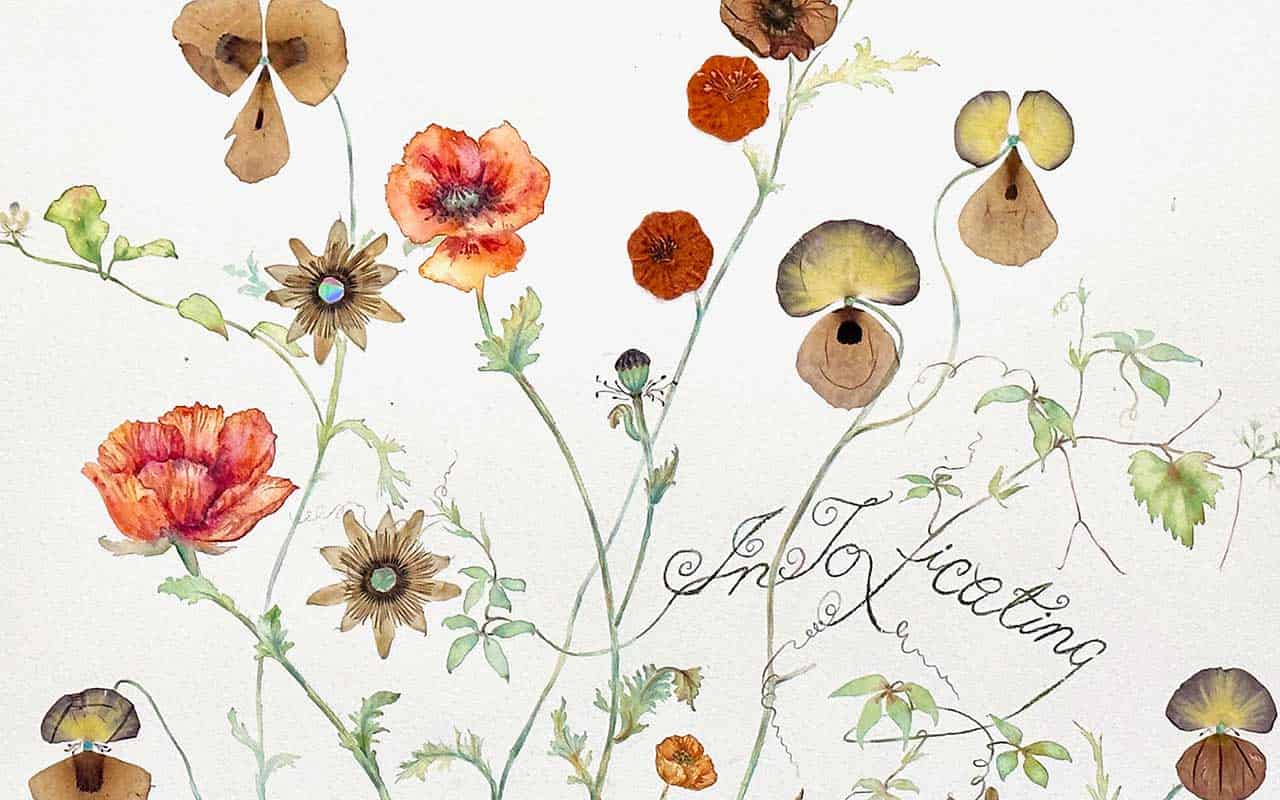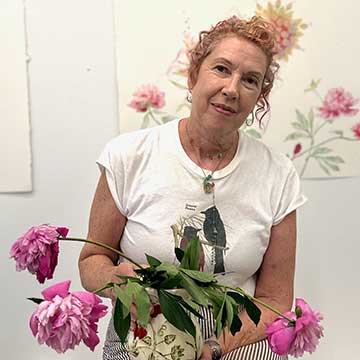Featured Artist

Gardens of the Anthropocene
“I have to work from life. If I work from a photograph or make it up it’s not the same.” The life that artist Marilla Palmer is referring to is nature, and very often, the gardens she cultivates. Palmer comes from a long lineage of garden enthusiasts and nature lovers, in particular her father, who instilled in her a love for gardening and an esteem for the natural world. The Anthropocene, the period in Earth’s history when human activity first began to have a significant impact on the planet’s climate and ecosystems, is the subject of Marilla Palmer’s most recent body of work.
Accept and embrace what is
Much of Palmer’s current watercolor collage work with flowers is a synthesis of native and non-native species. During her time in isolation in Lakeville, CT, Palmer turned to gardening where she “cultivated co-existence between native and non-native species.” She notes, “While the pandemic was raging we weren’t allowed to travel, but the foliage that I saw around me represented the gardens of the world: peonies from Eurasia, tulips from Turkey, nasturtiums from Mexico, and the native poppy, delphinium, and columbine.”
Palmer represents what she sees happening globally through her garden and her work. She plants all native seeds, but accepts that the garden is not going to stay that way. She believes eradicating non-natives is unrealistic. Instead, we should accept what is and work with what we have. What we have is like our gardens, and everyone’s garden represents plants from around the world.
 Palmer paints botanical watercolor collages in subtle shades of greens, blues, and pinks. They evoke a feeling of whimsy, gentleness, even kindness. In an essay on Palmer’s work, art critic Carol Kino notes, “it seems to beckon the viewer into a better world, where Mother Nature has been primped, primed, and gussied up to become all that she should be.”
Palmer paints botanical watercolor collages in subtle shades of greens, blues, and pinks. They evoke a feeling of whimsy, gentleness, even kindness. In an essay on Palmer’s work, art critic Carol Kino notes, “it seems to beckon the viewer into a better world, where Mother Nature has been primped, primed, and gussied up to become all that she should be.”
And while Palmer’s work certainly embodies a visually pleasing aesthetic celebrating nature, the incorporation of man-made materials in her collages hints at something darker. The beauty is seductive, but the purpose isn’t just to be pretty for pretty’s sake, it’s to open the viewer to a greater awareness of the natural world. Palmer’s work represents the anthropocene in showing how nature continues to try to survive despite technology’s intrusion and mankind’s attempts to contain it.
In her own words
I was born in New York City and grew up in Brooklyn Heights. I grew up going to museums, and my grandparents had a great collection of Japanese art. My father was a family court judge, and his whole mission in life was to make people’s lives better. My mother was an artist but during that time, in the 60s and 70s, it was very hard for women to have any real exposure as an artist, so even though she was very focused, she always struggled.
I started college as a liberal arts student but after meeting an inspiring woman from Paros, Greece, I decided to leave school to study art in Greece. I was taught by artists from all over the world, it was a life-changing experience that completely changed my perspective. Eventually I returned to the US and graduated from the Philadelphia College of Art.
The start of my career was really slow and hard. The art world was still very white male dominated. The possibility of making good money doing anything in the creative field was pretty limited. But the bohemian downtown scene in New York City was completely integrated and interesting – art shows were in rock and roll clubs: the first show I curated was at a drag club. It was fantastic to be in NYC at that time. It was very appealing to me to not make decisions in my life based on money, to have just enough to get by. It was possible at that time because rents were one-tenth of what they are now. It was a great feeling that even though everyone was struggling, everyone was in it together. Now I feel like there is a little bit of that vibe happening up here in the Hudson Valley. There’s a community feeling and a lot of start-up galleries.
Process
I grew up with the understanding that being an artist was a struggle. Then when I went to college, I met people who made me realize that art was expressive and joyful. The lesson for me was that my process had to be as pleasurable as possible, because most of the time that I was trying to be a professional artist, it was still very hard as a woman. We were still very underrepresented in galleries. Gardening is a big part of that, it’s pleasurable and healing, and that is a big part of my process. I want my work to reflect that.
Evolution as an artist
I have always had this feeling that I wanted my art to be personally meaningful, and I liked having a sense of fragility and poignancy in my work. I come from a long line of people who seemed to know the Latin and common name for every single plant. I’ve always loved gardening, but it was separate from my art. My father was a true environmentalist, a real nature lover. When he died was when I made the shift to more nature-based work. I felt like I needed it personally to continue my connection to him.
Anthropocene
Technology is here: we are in the Anthropocene. There is not one molecule on the planet that isn’t impacted by humans. Growing up in Brooklyn and living in New York City, I’ve been surrounded by some pretty fabulous examples of what humans can do, but then I’ll see a little crack in the pavement with a dandelion growing out of it. Humans can’t conquer nature, and nature will never be able to obliterate human presence on the planet. Everything is interconnected.
My bigger point as an artist is to really look at nature, because appreciation starts with looking. I always work with living plants, many of which I grow myself, and my work is in many ways botanical studies. One thing I like about using watercolors is that, like nature, you can’t really control them. As I’m painting something, it has to be done really fast, because it dries quickly. I want my work to have that feeling of movement, of evolving. Photography, fabric, and other elements blur the distinction between the real and the artificial. Is there any place on the planet where man hasn’t impacted nature? I want to draw attention to the beauty, power, and fragility of nature and the important role we have in protecting it. •
Marilla Palmer’s recent solo exhibitions include “Orchids of the Anthropocene” at Kathryn Markel Fine Arts, NY, and “Anthomania” at Furnace – Art on Paper Archive in Falls Village, CT. She has had numerous exhibitions in New York, Dallas, Los Angeles, and the Hamptons. Her exhibitions have been reviewed in The New York Times, The New Yorker, Time Out NY, ArtNews and The Lakeville Journal. To learn more about Palmer and her work you can visit her website at www.marillapalmer.com.

